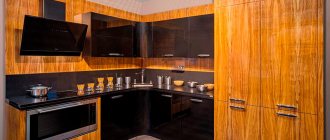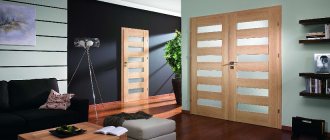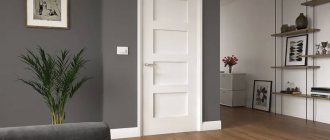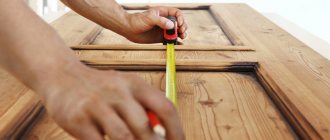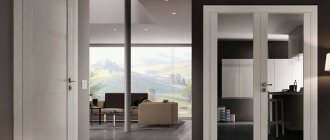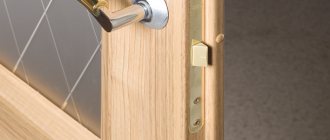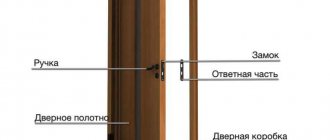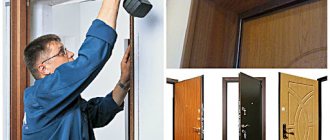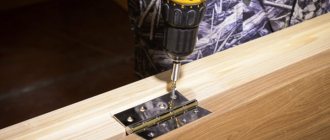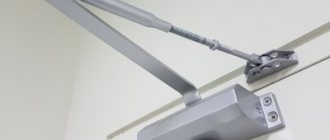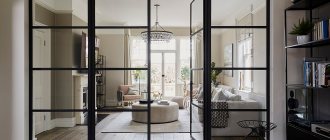The modern consumer is very different from the product consumers of the late 20th century. People have become more discerning. Many people, before going to the store, try to obtain basic information on the characteristics of goods and the criteria for their selection. They are especially keenly interested in those products whose production is on the rise, where there is a strong innovative breakthrough, where new technologies and materials are appearing.
One of these areas is the production of interior doors. Which is better - solid wood, natural veneer or its artificial analogue - eco-veneer? Let's figure it out together with the employees of the online store of interior doors "Into the House", who have prepared this expert material for you.
Which solid doors are better?
The production of interior doors has become so widespread today that some agencies are attempting to compile ratings of companies engaged in this field. The market is really oversaturated with offers. It would seem easier to buy the right product under these conditions. In fact, choosing an interior door from so many options, taking into account the variety of colors, textures and prices, is not an easy task, even if we are talking about a specific category of structures. Which solid wood doors are better, what to pay attention to when inspecting, what is primary and what is secondary - we suggest discussing these and other questions in our material.
The struggle for the quality of an interior door begins long before its production. Before falling into the hands of the manufacturer, it must go through several stages of preliminary preparation:
- The stage of selection of high-quality, environmentally friendly forest;
- Drying;
- Dissolution into lamellas;
- Gluing into a single sheet.
Taking into account the chosen style, paneled structures and doors are produced from laminated solid wood.
Wood selection
This means not only the type of wood, but first of all its quality. A simple buyer is not able to control the selection process of timber harvests, but you can ask the manufacturer about the origin of materials and check for certificates.
Proper drying
Only dry wood is used in the production of interior doors, in particular solid wood, brought to minimum humidity values - an average of 8%. There are two ways to achieve this level:
- Drying in natural conditions;
- Processing in drying chambers.
As a rule, manufacturers use the second drying method because it is faster. Rocks are dried in different ways, taking into account the characteristics of the variety, strictly maintaining temperature and pressure.
Division into lamellas
There are no interior doors made from a solid tree trunk. Immediately after drying, the workpiece is cut into small bars, which are then glued together to form a door leaf of the required size. In this way, manufacturers struggle with internal stress that arises during operation due to changes in temperature, humidity, and pressure. If you simply cut a door from a single piece of solid wood, it will be very sensitive to changes occurring in the environment, which means it will quickly dry out, crack, and become unusable.
Wood protection
The protective properties of the future structure are imparted in two ways - by impregnation with some special compounds and by applying others to the surface of the canvas or molding. The materials used for external protection are also endowed with decorative properties. On sale there is a large collection of primers, stains, waxes with antibacterial and antifungal properties, as well as varnishes, paints, enamels with various tinting options.
Which doors are better
A beautiful and stylish interior door that matches the color of the created interior design, as well as being durable, moisture-resistant and inexpensive, is considered ideal. In real life, it happens like this - the highest quality and most durable doors cost from 50,000 rubles, so sometimes you have to neglect your image and priorities in order to fit within the available budget. And the point is not that a door costing 20,000 will cause a lot of trouble during operation, but that such a model does not have elite status, which is of primary importance for some buyers. Therefore, it is impossible to answer in a nutshell - which solid doors are better? Everyone chooses according to the overall style and price. To make it easier to choose, we suggest evaluating products that are similar in characteristics and cost.
Pine or alder
Based on the intended installation location:
- Pine with its beautiful pattern - for a country house, a country house or a cottage;
- More durable alder - for apartments, preferably in rooms with a classic dominant feature.
Alder or beech
They have approximately the same moisture resistance parameters and a lot of finishing methods. Beech is superior in strength, but alder has a more expressive pattern and lower cost. It is hardly possible to give categorical advice on the place of application of one or the other array. If you want more natural beauty, then alder. If you are satisfied with aristocratic homogeneity and a higher price - then beech.
Ash or oak
It will be difficult for a non-professional to distinguish them from each other. Look at the cut - the oak has pith rays on the surface. Ash does not have them. Ash is stronger, but this does not mean that an ash door is better. On the contrary, oak in the minds of most buyers expresses stability, strength, power and almost eternity, therefore, which is better - you will decide on the spot, when comparing the external characteristics of two specific models.
Plastic
Plastic doors are suitable for installation in any room, but they will look most appropriate in the bathroom or on the balcony. As for the aesthetic side, such models evoke associations with an office or institution, and not with home comfort. Therefore, they are rarely used in apartment interiors, more often in rooms decorated in pop art and art deco styles.
Plastic doors can have glass inserts, both in the form of regular double-glazed windows and stained glass, frosted, with a pattern.
There are also options made from PVC profiles, which can be decorated to look like wood. Such models have all the advantages of plastic doors, but they look more homely.
Choosing veneer doors
The majority of the collection of interior doors is occupied by veneered products, because in terms of external characteristics they are no worse than solid wood doors, but cheaper. A completely appropriate question is which veneer doors are better. Indeed, they differ from each other not only in color, but also:
- Construction: paneled (classic), drawstring and molded - for modern interiors;
- Type of veneer: natural, fine-line;
- Price: the less synthetics, the more expensive.
The process of applying veneer to canvas is called veneering. All existing types of wood are used - this means the solid wood itself or its imitations in the form of various films, but more on that a little later. First, you should answer the main question - why make veneered doors if you can simply cut the door from a piece of solid wood of the desired type? But there is a motive for this, and more than one.
Advantages of veneered doors:
- Relatively low price: the difference is felt especially strongly when purchasing several models;
- Allows you to buy a door with the same natural coating and refuse synthetics if there is no financial opportunity to order solid wood doors;
- High level of moisture resistance - can be installed in bathtubs and showers;
- Little weight.
Design diversity is achieved by using veneer from different types of wood - from simple pine to expensive oak, exotic rosewood - and modeling the base, creating milled, paneled, drawer structures.
Types of veneer
Veneer differs according to the manufacturing method:
- peeled (when rotating a steamed log, a thin strip is cut parallel to the grain)
- planed (logs are sawn into bars and the strip is cut perpendicular to the grain)
- sawn (the method of cutting into planks is used, exclusively varieties of coniferous trees)
- fine-line (combined painting, gluing, pressing, cutting to reproduce the texture of valuable species)
By appearance:
- natural (non-painted veneer with natural texture)
- colored (color change with dyes)
How to find out which veneer door is better and of higher quality
There is another way to diversify the collection of apartment doors, but it is used within the “veneered doors” category itself. Classification is carried out according to the type of veneer used. As you know, there are 3 of them:
- Natural (natural);
- Fine-line;
- Eco-veneer
The first is the most expensive because it is made by cutting a thin layer of wood. The same array, but in the form of a film up to 1 mm thick. The second option is also made from wood, but using a different technology. First, the wood sections are glued into one sheet of plywood and then it is cut into thin layers. Eco-veneer is made from pulp industry waste and polypropylene. Door covering materials are listed in descending order of price.
Interior door with ash veneer finish
How can an ordinary person distinguish a door made of natural veneer from eco-veneer and fine line:
- Veneer is an exact imitation of solid wood, with the same beautiful pattern and texture;
- The fine line has many repeating fragments on the surface;
- Eco-veneer is a polymer. Look at the end sections, you can see that this is a film and not a cut of wood. And the second point is that eco-veneer comes in a wide range of colors, including those that are not found in nature.
How to find out which veneer doors are better and of higher quality? Don’t be afraid to touch the canvas, even smell what it smells like. A good door has an absolutely smooth surface and no pungent chemical odors.
Which is better – doors made of solid wood or veneer?
There is an opinion that the choice between doors made of veneer and solid wood is made solely because of the price. The statement is true, but partly, and does not work in all cases. For example, models made from inexpensive solid pine may cost the same or less than beautiful paneled doors made from natural oak veneer.
Interior doors with oak veneer finish
What is better – solid wood or veneer? We suggest making a comparison based on key parameters:
- Scope of application: solid wood doors are installed in richly decorated living rooms, halls, as well as in houses and offices with luxury finishing. Veneered models are less picky about their surroundings, although in order to install a door in the middle and mid-price segment in a room, you need to comply. They are also ordered for apartments, offices, country houses, but they are not necessarily fit into exquisite interiors and expensive antiques are selected as a background;
- Moisture resistance - it is believed that veneer copes better with high humidity, although this criterion depends not so much on the material itself, but on its protection. Still, if you need a door for the bathroom, it is better to get by with veneer so as not to risk a lot of money;
- Price is the undisputed priority on the side of veneer doors. Solid wood is always more expensive than thin cut wood, although if two models are identical in design, is it worth paying more?
- The ability to eliminate defects on the surface: solid wood doors have more of them, although there are special compounds that can be used to make scratches on the veneer invisible, if not eliminated.
Another advantage of veneer doors is their low weight. Installation of solid wood products is usually carried out on three loops. In the case of veneer, reinforcement is not required.
Advantages of natural veneer
- environmental friendliness
- cost (depending on the type and method of production, budget and status option)
- impact strength
- additional sound insulation
- wide range of applications, not limited to interior and entrance doors
- with the use of protective mixtures, liquids and varnishes, the impact of the environment is reduced (durability increases)
Eco-veneer, with imitation of valuable varieties, will cost much less than the original veneer, will not require additional care and will last a long time. Natural veneer produced using the fine-line method will also be cheaper than peeled and sliced veneer. And treated with special compounds will be no less durable.
There are a huge variety of veneers and eco-veneers on the building materials market. Which successfully compete and replace each other. When choosing, you should pay attention to the manufacturer, the declared quality of the materials and environmental friendliness. There is no clear answer to the question of which is better. The choice is yours! We can provide recommendations on the general selection of interior doors.
Source: kvartirnyj-remont.com
Solid pine or veneered
Pine, as the cheapest material among all common alternatives, is the only type used in the production of solid wood models and veneered doors.
In the first case, the entire canvas is made from pine, and then it is covered with stains, wax, decorated with colorless varnish or tinted.
Veneered pine doors are produced for two purposes - to improve external appearance and protective properties. To cover cheap wood, use expensive oak or ash veneer. Thus, an inexpensive structure with a rich design is obtained. As for protection, we have already talked about the outstanding characteristics of natural veneer. In the case of solid pine, such a technological solution is especially relevant, because veneering can significantly increase the moisture resistance and strength of soft wood, and therefore extend its service life without significantly raising the price tag.
How to prioritize? – It’s very simple: if you want to decorate your house with natural wood, and also bring the fresh aroma of pine needles into the room, choose solid pine, but this solution is more suitable for dachas and country houses. If you need a classic, rich, saturated color of oak, and don’t have to overpay for re-laminated elite solid wood, then we suggest buying a veneered interior door.
Solid pine door
Solid alder or veneer
Alder is stronger than pine, but according to this criterion it is almost on the same level as natural veneer. Since both types of doors are treated with protective compounds, manufacturers manage to equalize the compared designs in terms of moisture resistance. There are no fundamental differences between them in price. This means that there are no serious indications for refusing to purchase a veneered door or an alder model. How to choose? – Most likely, we will decide on the spot. However, if you need to buy a product exactly to match the colors and patterns. Alder is a tree, which means respectability and a bias towards strict classics.
Solid oak or veneer
Solid oak is the peak value in many respects, including durability, chic design - or rather, a great variety of designs that fit into the classic style. They are superior to their veneered copies in weight and price, although this is rather a disadvantage than an advantage.
Veneered doors are also beautiful, but in a different format, because, for example, veneer is not suitable for aging by brushing, but here you can use much more compounds to give a shade, which means it’s easier to choose a model for parquet or baseboards. They are inferior in strength, but gain in moisture resistance and, of course, in cost.
Total: if you prefer to maintain your status at any cost, then choose solid oak. When you want equally high aesthetics for less money, we take natural veneer.
Criterias of choice
For the consumer, the most important parameters are
- price,
- quality, durability,
- convenience,
- appearance, style.
Based on this, you can find a suitable option for any consumer needs and in any price range. A variety of materials provides this opportunity. The video below describes the main advantages and disadvantages of different materials.
How to choose eco-veneer doors
Eco-veneer doors are a timely and smart solution to create a cheaper alternative to doors made of natural veneer. It is unlikely that it would occur to anyone to say that anyone can afford a product worth 6-10 thousand rubles. The reality is that we have to consider more affordable options, but I would like them to be durable, beautiful, and moisture-resistant.
The second point is weight loss, and all with the same goal of saving. As a rule, such models are made from hollow structures or filled with cheap material, such as honeycomb cardboard. The result is a lightweight, inexpensive product, but with minimal values of heat and sound insulation.
Interior doors finished with eco-veneer
Which eco-veneer doors are better depends largely on the manufacturer’s desire to meticulously select materials, relate to assembly, and not neglect modern technologies.
How to obtain eco-veneer
Eco-veneer is based on 2 key components – cellulose fibers and polypropylene. The film is produced by long-term pressing. The result is a very durable material that is resistant to moisture and scratches.
The film is applied to a previously prepared, well-cleaned canvas using a special technology: first it is heated, then the structure is placed in a vacuum for a strong connection. This is done on the so-called “enveloping line”. The polymer is not cut into separate fragments to cover each side and ends separately, but it is used to wrap each element of the door - drawers, moldings. The joint is made in only one place, and it will not remain outside, but will fit into the groove. Thus, only the top and bottom ends will be open.
Eco-veneer is dyed in bulk, at the stage when the film consists of cellulose fibers. First they are given a shade, after which they are glued and molded under pressure. Thanks to this color application technique, the door remains just as rich and fresh after many years of use, and it does not need to be hidden from direct sunlight to prevent fading.
Practical advantages of eco-veneer
The film is used for finishing natural and artificial materials, so underneath it there may be solid pine, MDF, chipboard. Briefly about the advantages of such models:
- Available in a wide range of colors - from natural to creative;
- Color fastness;
- Surface durability: resistant to scratches and impacts;
- Moisture resistance – installation in bathrooms is allowed;
- Does not scratch when washed with abrasive detergents - soda, powders;
- Repairable: over time, you can apply varnish or paint with a different shade to adapt to the new interior.
Doors coated with eco-veneer for bathrooms and toilets
Recommended areas of application - apartments, country houses, cottages, offices, shops, medical institutions, sanatoriums, public places, etc. Such a wide scope of use is explained by low price, durability, and variety.
Which eco-veneer door is the best: we check the quality according to 5 parameters
Pay attention to:
- Construction.
- Film.
- Glass fastening.
- Moldings.
- Build quality.
Checking the design
Doors made of eco-veneer are made with a blank panel or drawer panels. Drawbars are produced in different sizes - width varies between 90-150 mm, thickness 30-45 mm.
Please note that the wider the drawers, the easier it is to install magnetic locks. Such systems are good for hotels and offices, but are not always relevant in apartments. Wide drawers are not appropriate on narrow doors (up to 70 cm) - they greatly spoil the design and burden the appearance.
In budget models, drawers up to 36 mm in thickness are used. They have minimal bending strength. It is difficult to install fittings in them. Therefore, designs with drawers with a width of 36 mm, but not more than 40 mm, are considered optimal.
When choosing a door, check whether it is sagging. Try to lift it to determine the weight, at least by eye. Despite the hollow inserts, it should not be very light.
Checking the film
The thicker the material, the stronger it is. A similar rule applies when choosing film. The thinner the eco-veneer, the more vulnerable it is, the easier it is to scratch. You can check the thickness by the open ends at the top of the canvas. Or ask the seller for cross-sectional samples of models.
Checking the fastening of glass and panels
When choosing doors with glass inserts, two important points are important: their strong fastening and thickness. Try opening and closing the door several times, listen to the sounds, there should be no rattling or feeling that the glass inside is “moving”, which means it is poorly secured and the manufacturer decided to save on the seal.
The panels can also be of different thicknesses. Optimally – 10 mm. There are cheap designs with 6-8 mm panels. These have lower not only price, but also sound insulation and durability.
Checking the moldings
Please pay attention to the following details:
- The thickness of the frame: it should not be very thin, otherwise the door will sag over time, and it is difficult to install such moldings;
- Compliance of eco-veneer: the coating on the molding and the canvas must be identical
Assembling side doors
Assembly is carried out in two ways:
- By gluing on a vime;
- Twisting with screws.
Glued doors are cheaper because they are produced by gluing under pressure and are non-removable. Doors made of eco-veneer, connected with screws and dowels, are considered the best in terms of strength. This approach prevents sagging - firstly, and secondly, it allows you to make a collapsible structure. If suddenly one part becomes defective, it can simply be replaced with the same one in the factory.
Drawer doors coated with eco-veneer in wenge color
PVC doors or eco-veneer – which is better?
Two key materials for decorating the facade of interior doors. Both are actively used by manufacturers of products in the low and mid-price segment. A logical question for consumers is which is better, PVC or eco-veneer. How do you differentiate one coating from another, is there a reasonable explanation for giving up one for the other?
Let's start with the similarities:
- They are film materials;
- Supplied in rolls;
- Resistant to moisture;
- More durable than paper-based laminated coatings;
- They are cheaper than doors made of solid wood and natural veneer.
Differences
Texture: the first distinguishing feature. If you run your hand over the surface of each, the PVC will reveal a smooth, even texture. Eco-veneer in this regard is closer to natural wood, because it imitates it not only visually, but also has a similar structure.
Safety: eco-veneer wins. Its attachment to the surface is carried out without the use of special compounds - the connection occurs under pressure due to the substances that make up the film itself. PVC and natural veneer are fastened using strong synthetic binders.
The second point is that both materials are polymers, only PVC is actually polyvinyl chloride, eco-veneer is polypropylene. The second does not contain toxic chloride, therefore it is considered the most beneficial in terms of environmental friendliness, although this statement is controversial, and the pronounced harmful properties of PVC appear only under certain conditions.
Both PVC and eco-veneer repel moisture and are suitable for installation in bathrooms, including in close proximity to sinks, but PVC doors:
- It is not recommended to wash with highly abrasive products;
- It should not be installed in places where powerful ultraviolet radiation is always present. This will damage the texture;
- They require careful handling, because scratches, cracks, and chips resulting from strong impacts cannot be eliminated without leaving a trace.
Eco-veneer is just as beautiful, natural in appearance, and not expensive at all. Its most vulnerable point is its strength; it depends on the thickness of the film. It’s not all good that it’s completely cheap: a very low price should alert you and force you to check the unprotected end cuts. Well, if careful operation is expected, then there are no visible reasons for refusing to save money.
Door designs made of PVC and eco-veneer
Film materials are the finishing coatings for doors. They do not need to be painted, waxed, or tinted. They cover the entire existing range of doors, including:
- Tsargovye;
- Panel;
- Milled.
It is necessary to evaluate the quality in each specific case, regardless of the coverage, which means we look at:
- Upper unclosed ends or ask the seller for a sample to evaluate the thickness of the film;
- Weight, and too light models, is not always a plus, because they become the most vulnerable to strong impacts;
- Fastening panels and glass - there should be no sensation of loose inserts;
- The thickness of the box and accessories: we choose according to the principle “where it’s thin, that’s where it breaks.”
Film coatings allow you to choose the color of the door to suit any interior, but let’s make a reservation that this is easier to do when choosing PVC models. The film is produced in the entire palette of the RAL catalogue, and these are several dozen options, differing in barely noticeable nuances. Eco-veneer in this sense is slightly inferior to its “older” polymer, but its external characteristics are absolutely similar to the appearance of natural wood.
Eco-veneer is supplied in the colors of bleached oak, wenge, apricot, etc. Such a door looks like a model made of natural wood, and only this opportunity - to buy richly decorated doors at a low price - is the primary reason for their appearance on the market.
So, a PVC door is a thicker and more durable coating, but its synthetic origin is immediately noticeable due to the lack of texture. On the contrary, eco-veneer is the same naturalness, but too thin to enter the premium segment. This means that you will have to choose based on priority, because, as often happens, beauty is important to some, and strength to others.
Which interior doors to choose – veneer or PVC
Doors made of PVC and natural veneer differ from each other fundamentally, if only in that one is made of natural material, and the other of synthetic. Different origins to one degree or another affected all the characteristics of the models, including price, design, performance properties and design. We propose to dwell on them in more detail.
Price
Of course, if you compare high-quality doors made of oak veneer with PVC models, the price preponderance towards the former is too obvious. In fact, these are doors from different “weight” categories: one is classic, luxurious and the most wooden, and the second can be present in a wide variety of interior styles, because it comes in any color - from neutral brown to creative red, has smooth surface, which immediately reveals its synthetic essence.
If there are models in the categories under consideration that are similar in properties, then these are structures with PVC coating and interior doors with FineLine coating. In another way, it is also called engineering veneer, because it appeared as a result of the use of innovative technologies. To obtain it, they take real wood shavings. The layers are stacked on top of each other in a specific order to create a pattern. The workpiece is dried in an oven and then cut into cross layers. The result is a thin, inexpensive, but natural material without knots. You can distinguish it by eye from natural veneer by its ordered pattern with repeating fragments. Thin coating is inexpensive and can compete in price with PVC doors.
Veneered door in bleached oak color
Design
In this parameter they are similar. Both options are used to cover two types of canvases:
- Made from inexpensive solid pine with MDF panels;
- From re-glued solid wood.
Mainly solid coniferous species and alder are used, because covering elite types of wood with synthetics or natural veneer is not advisable, if not stupid. The main thing is to pay attention to the thickness of the coating material, build quality, and weight. The heavier the canvas, the better. This means there is a more expensive amplifier installed inside than honeycomb cardboard.
External attractiveness and diversity
Inexpensive does not mean ugly. PVC doors can also look natural. It can be difficult to immediately discern their unnatural origin, but it is possible.
As for the most primitive representative of the “family” of veneers - Fine-Line film, it looks adequate for its origin and price, i.e., quite decent.
Performance characteristics
The quality of films today is so high that you don’t have to worry about easily scratching or breaking the door. PVC does not require a strict selection of detergents - ordinary chemicals and a rough cloth will do. Two disadvantages that cannot be ignored:
- The weak point of PVC doors is the edges. If the processing is poor or the recommended operating standards are not followed, they may come off;
- If the coating begins to peel off, it is impossible to repair it at home - you will have to take it to the factory, which is not always convenient or profitable.
Veneer cannot be used without additional protection, so the surface is varnished. There are no butt seams or edges left on it, which means veneer doors have less chance of failure. Even if a crack or chip forms on the surface, they can be easily repaired with your own hands, and the defect will not be visible.
Which is better – veneer or eco-veneer
Buyers had hardly understood what veneer was before its “same-root” analogue appeared on the market. What to do with him? What relationship do the materials have to each other, and what is better - veneer or eco-veneer - consultants have to answer these and other questions more often than others.
Veneered doors to the bedroom and wardrobe
Natural veneer is made from different types of wood, and eco-veneer is an inexpensive polymer that was invented specifically to satisfy the needs of people with low wages for a high-quality and beautiful product. In essence, eco-veneer is an artificial imitation of its natural counterpart, hence the difference in cost. And what is better to choose - everyone decides for himself:
- Or several light, inexpensive doors with a waterproof but thin film that exactly replicates the texture of an elite solid wood;
- Or more durable, status and attractive classics, but in smaller quantities.
Laminated: cheap, “paper”, cannot be repaired
Among all the diversity of the door world, laminated doors are considered the cheapest. The technology for their manufacture is extremely simple. First, a wooden supporting frame is made (usually from pine beams, MDF or chipboard), then thin sheets of MDF or fiberboard are attached to this frame on both sides, and the void between them is filled with cardboard, reminiscent of a honeycomb. The facing material is a film based on special paper impregnated with resins and coated with a protective varnish. The design on paper imitates the structure of natural wood, but upon closer inspection the difference is easily noticeable.
Finish film is the cheapest and most short-lived material. In a humid environment, such a door may become unsightly in a year or two; the film at the ends may begin to peel off from the MDF sheet or bubbles may form. Doors lined with laminate, a multi-layer paper film, are more expensive. According to the manufacturers, this coating has increased durability compared to finishing film.
However, unfortunately, laminated doors have more disadvantages than advantages. Due to thin MDF sheets and honeycomb construction, they are not durable. Such a door can easily be broken through with a punch. Damaged coating cannot be repaired or restored; you will either have to mask the flaws or replace the entire door. Sound insulation also leaves much to be desired.
— Another name for laminated doors is laminated. Roughly speaking, it's paper. Such doors were extremely popular 12 years ago, as soon as they appeared on the market. At that time, they looked modern, and were much cheaper than solid wood and veneer. Due to this, sales soared to 80-90% of the total turnover, recalls Mikhail. — By today’s standards, you must admit, they look too budget-friendly and over the years of operation they have not proven themselves to be the best. In terms of price, laminated doors are already approaching eco-veneer, but are seriously inferior to it in terms of quality.
— The ratio is approximately this: for every ten doors purchased, there is only one laminated one. This is the best case scenario. Now few people are interested in them. If people make repairs for themselves, then they try not to save on such things. Laminated doors are used mainly for rented apartments or when an old apartment is being prepared for sale, in order to give it a marketable appearance, says Alexander Krupsky, director.
